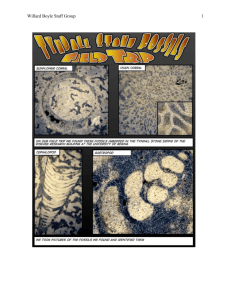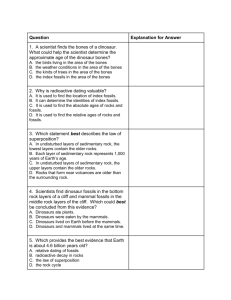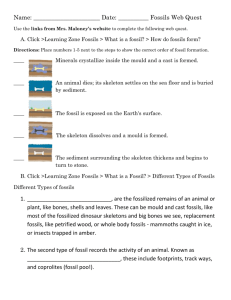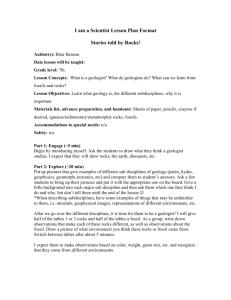What does the fossil record show?
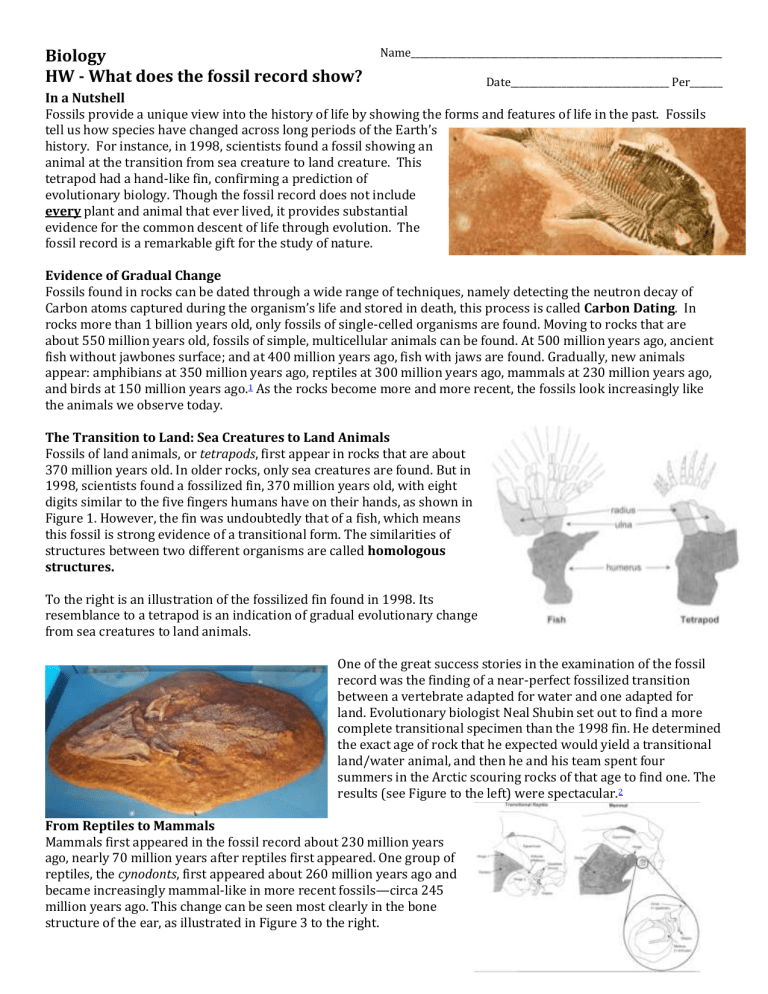
Biology
HW - What does the fossil record show?
Name___________________________________________________________________
Date__________________________________ Per_______
In a Nutshell
Fossils provide a unique view into the history of life by showing the forms and features of life in the past. Fossils tell us how species have changed across long periods of the Earth’s history. For instance, in 1998, scientists found a fossil showing an animal at the transition from sea creature to land creature. This tetrapod had a hand-like fin, confirming a prediction of evolutionary biology. Though the fossil record does not include
every plant and animal that ever lived, it provides substantial evidence for the common descent of life through evolution. The fossil record is a remarkable gift for the study of nature.
Evidence of Gradual Change
Fossils found in rocks can be dated through a wide range of techniques, namely detecting the neutron decay of
Carbon atoms captured during the organism’s life and stored in death, this process is called Carbon Dating. In rocks more than 1 billion years old, only fossils of single-celled organisms are found. Moving to rocks that are about 550 million years old, fossils of simple, multicellular animals can be found. At 500 million years ago, ancient fish without jawbones surface; and at 400 million years ago, fish with jaws are found. Gradually, new animals appear: amphibians at 350 million years ago, reptiles at 300 million years ago, mammals at 230 million years ago, and birds at 150 million years ago.
1 As the rocks become more and more recent, the fossils look increasingly like the animals we observe today.
The Transition to Land: Sea Creatures to Land Animals
Fossils of land animals, or tetrapods, first appear in rocks that are about
370 million years old. In older rocks, only sea creatures are found. But in
1998, scientists found a fossilized fin, 370 million years old, with eight digits similar to the five fingers humans have on their hands, as shown in
Figure 1. However, the fin was undoubtedly that of a fish, which means this fossil is strong evidence of a transitional form. The similarities of structures between two different organisms are called homologous
structures.
To the right is an illustration of the fossilized fin found in 1998. Its resemblance to a tetrapod is an indication of gradual evolutionary change from sea creatures to land animals.
One of the great success stories in the examination of the fossil record was the finding of a near-perfect fossilized transition between a vertebrate adapted for water and one adapted for land. Evolutionary biologist Neal Shubin set out to find a more complete transitional specimen than the 1998 fin. He determined the exact age of rock that he expected would yield a transitional land/water animal, and then he and his team spent four summers in the Arctic scouring rocks of that age to find one. The results (see Figure to the left) were spectacular.
2
From Reptiles to Mammals
Mammals first appeared in the fossil record about 230 million years ago, nearly 70 million years after reptiles first appeared. One group of reptiles, the cynodonts, first appeared about 260 million years ago and became increasingly mammal-like in more recent fossils—circa 245 million years ago. This change can be seen most clearly in the bone structure of the ear, as illustrated in Figure 3 to the right.
As shown in the previous image, transitional fossils of cynodonts to mammals had two jaw hinges. These fossils date from a time when the dentary and squamosal bones of cynodonts were beginning to take over the role of jaw hinge (hinge #2). This allowed the articular and quadrate bones to evolve into the second and third bones of the mammalian ear, as shown on the right. Today, both reptiles and mammals have the same bones in their ear/jaw region, but have adapted different locations and for different purposes. The similarities of ear bones between reptiles and mammals are also called homologous structures like the example of hand bones above.
Transitional Forms: Few and Far Between
Transitional forms occur just when one might expect to see a change from one body type to another. However, a common objection is that few transitional fossils have been discovered; thus many lineages cannot be traced smoothly. This is a key argument for those who attempt to refute evolution.
However, there are several reasons for these gaps in the fossil record. First, fossilization is a rare event, happening only to a handful of trillions of dead organisms. Moreover, transitional species tend to appear in smaller populations, where rapid changes in the environment can provide a stronger evolutionary drive. Finally, because fossilization itself is a rare event, smaller populations are sure to produce fewer fossils. The fact that transitional species have been found at all is remarkable, and it offers further support of gradual, evolutionary change.
Reading Questions:
1.
If the fossil record does not show every organism that has ever existed, how do you think scientists draw conclusions from their findings?
2.
What technique allows for once living fossils in rocks to be dated as far as billions of years ago?
3.
What are homologous structures? How do they show similarities between separate species?
4.
When did the first mammals occur on earth? What was is most closely related to? How do we know?
5.
Explain why it is difficult to find perfectly transitioning species in the fossil record.




